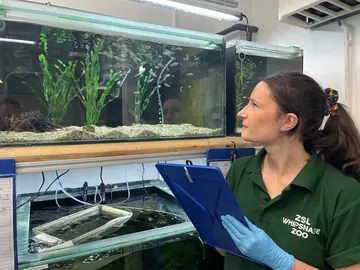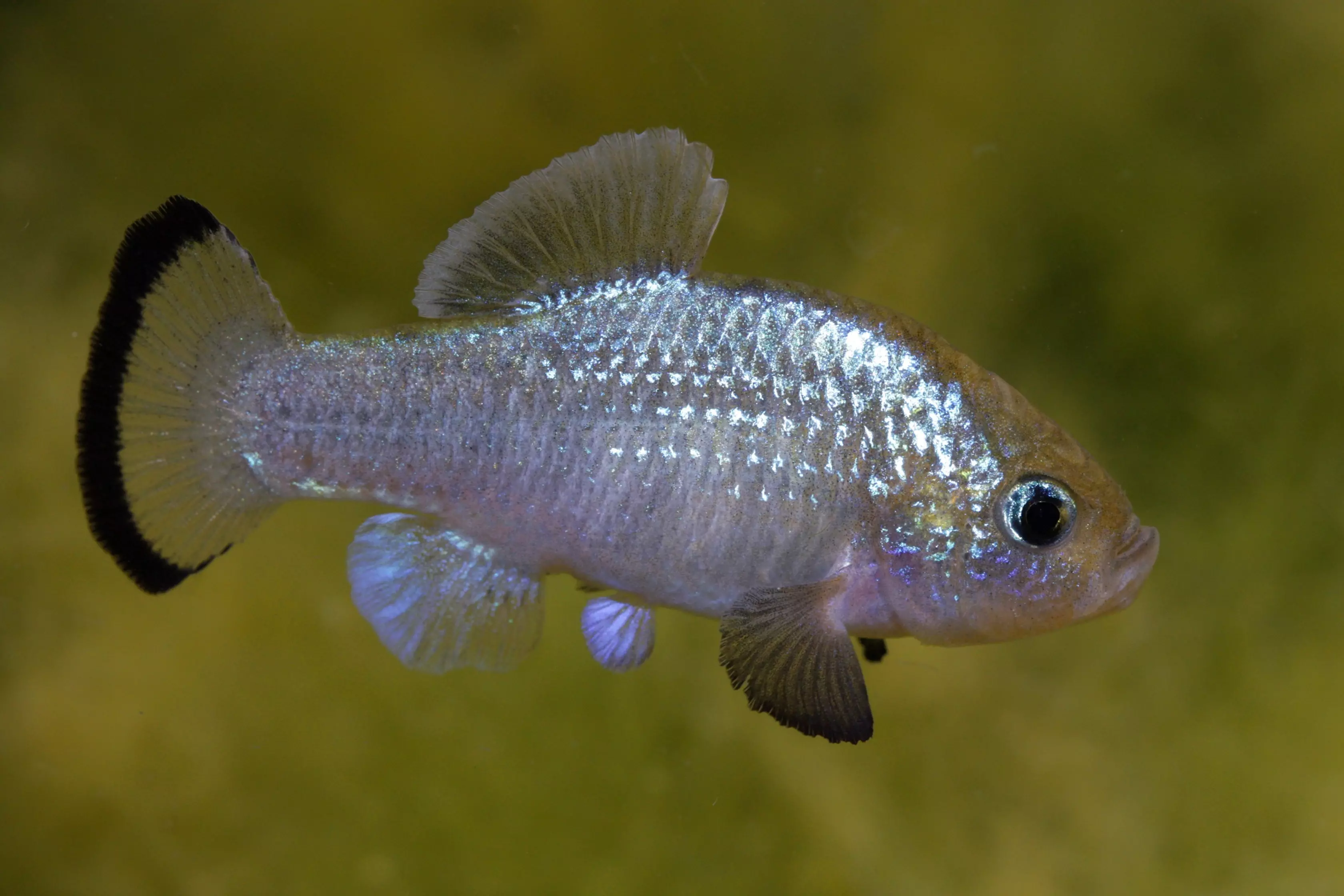The Potosi, La Palma and Charco Palma pupfish are Extinct in the Wild. They only exist under expert human care in zoos or aquariums, and their future is entirely in our hands.
At ZSL, we’re working with partners to learn more about these fascinating fish, breed them at Whipsnade Zoo, and ultimately reintroduce them to their indigenous range in Mexico so they can swim in the wild again.
What are pupfish?
There are more than 40 species of pupfish, primarily in Mexico but also the southern United States and Caribbean islands. Many of these fish have limited ranges and are highly threatened.
Three Mexican pupfish species – the Potosi pupfish (Cyprinodon alvarezi), La Palma pupfish (Cyprinodon longidorsalis), and Charco Palma pupfish (Cyprinodon veronicae) – can be found in Whipsnade Zoo’s freshwater fish Aquarium. But these are some of the last remaining populations in the world. They have disappeared from their natural homes and are Extinct in the Wild.
Potosi pupfish
Scientific name: Cyprinodon alvarezi
Range: Nuevo León state, Mexico
Conservation status: Extinct in the Wild
La Palma pupfish
Scientific name: Cyprinodon longidorsalis
Range: Nuevo León state, Mexico
Conservation status: Extinct in the Wild
The La Palma pupfish had one of the smallest native ranges of any vertebrate species, once living in an area only around 10m2 about the size of a large garden shed.
Charco pupfish
Scientific name: Cyprinodon veronicae
Range: Nuevo León state, Mexico
Conservation status: Extinct in the Wild
Why did these pupfish species go extinct?
The Potosi, La Palma, and Charco Palma pupfish that were once endemic to Mexico, are now not found there at all.
They lived in relatively close proximity in springs within the Nuevo León State in Mexico, but these springs dried up as more groundwater was taken for farming to feed a growing human population. The fish were Extinct in the Wild by the mid-1990s, and they now only exist in aquariums and conservation zoos, like Whipsnade Zoo.
We’ve forged a dedicated conservation alliance with partners to halt human-induced extinction and drive the recovery of the most threatened species on the planet. Many Extinct in the Wild species urgently need our help, and we are working to give them a life beyond extinction.
How are we working to conserve the Mexican pupfish?
Together with partners, we’re revitalising the Mexican pupfish populations.
In 2019, the EAZA Freshwater Teleost Taxon Advisory Group (TAG) and Cyprinodontidae European Endangered Species Programme (EEP) were established to prioritise the Potosi, La Palma, and Charco Palma pupfish. We’re working to carefully manage their populations and understand the wider plight of freshwater fish in Mexico and efforts to conserve them. We’re breeding the pupfish under human care with the aim of responsibly releasing them into safe, wild habitats in the future.
Download our Conservation Action Plan
Breeding the fish
All three pupfish species were successfully rescued and housed in ex situ facilities, including Whipsnade Zoo, where we’re breeding the fish in our Aquarium. Pupfish have short breeding cycles. This means they can breed readily in conservation Zoos, providing individuals for a release back into the wild in the future, without jeopardising the source population. They also then have the ability for rapid population establishment and growth after being released into the right environment.

Finding the best location for release
The pupfish were wiped out due to poor environmental management of water resources, which was exacerbated by climate change, so choosing the right release site is vital to the success of the project.
We need to determine the best location for release of each species based on currently available water resources, isolation from pollutants and non-native species, and the ability to restore or create persistent water bodies.
Working with local communities
An important part of reintroducing the fish back into the wild involves engaging with local and national communities to raise critical awareness of the plight of Mexico’s pupfish and gain their support.
Many Mexicans, won’t have seen these pupfish for at least 30 years, so an entire generation has grown up using groundwater without considering the species that once relied on it.
The successful wild recovery of the fish will require changes in local behaviour toward pupfish and environmental protection, and we’re working to empower local populations by building pride and ownership of their fish.
The vision
- All three species of Extinct in the Wild pupfish will be restored to their indigenous lands where they will thrive as viable and vibrant in situ and ex situ populations.
- They will meet downlisting criteria to no longer be considered as Extinct in the Wild on the IUCN Red List within 10 years.
- Communities will become active stewards of the fish and take in the restoration of their local environment.
- Through the example of the pupfish we will inspire hope that a return to the wild is possible for Extinct in the Wild species.
We’re ultimately working towards establishing the first wild populations for each species in nearly three decades. Our plan is responsible yet bold and will draw on cutting edge conservation science in line with IUCN best practice.
Whipsnade Zoo is a Conservation Zoo
We're breeding some of the rarest fish on earth
Our Aquarium is a hub for global conservation as we work to recover some of the most endangered fish species in the world.
Together with the following partners, we're working to protect Extinct in the Wild Mexican pupfish
- Universidad Michoacana de San Nicolás de Hidalgo (co-lead)
- Bristol Zoological Society
- Universidad Autónoma del Estado de Morelos (UAEM)
- Acuario Inbursa (AI)
- Sealand Monterrey
- Universidad Autónoma de Nuevo León (UANL)
- San Antonio Zoo
- Berkeley University
- Guadalajara Zoo
- Vienna Zoo
- RioVivo
- University of the West of England
- Instituto Mexicano de Tecnología del Agua IMTA
- IUCN Species Survival Commission Conservation Translocation Specialist Group (IUCN CTSG)
